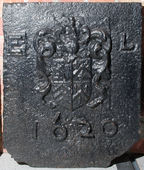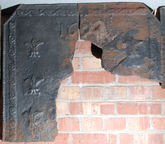-
916
Description: Rectangular, with a detached pediment joined by rebated scrolls; cavetto-moulded edging; circular 'shield' in a cartouche, surmounted by an esquire's helm and lion rampant crest, with mantling behind; initials split by crest; date split in top corners.
Notes: The armorial is of David Prichard (d. 1630) of Llancaiac Fawr Manor; the blazon follows the patriarchal tradition of Welsh heraldry: quarterly, 1st, Sable a lion rampant Argent (for Cydrych ap Gwaithfoed), 2nd, Sable a chevron between three fleurs de lys Argent (for Einion ap Gollwyn), 3rd, Gules three chevrons Argent (for Iestyn ap Gwrgan), and 4th, Sable a chevron between three spear-heads Argent (for Bleddyn ap Maenyrch); the '8' of the date has a flattened top. A copy, from a broken original.
Inscription: D P / 16 28
Arms: Prichard (or ap Richard)
- Decoration tags:
- rectangular with detached pediment (shape)
- cavetto (edging)
- whole carved pattern
- armorial
- text
Manufactured: in 1628 possibly at Dyffryn Furnace in the South Wales area of Wales.
Current location: Llancaiach Fawr Manor, Nelson, Caerphilly, Glamorgan, Wales.
Museum number: GTJ75111 (part of the Caerphilly County Borough Council Museums & Heritage Service museum group)
- Attached to series:
- Personal armorial firebacks
- Welsh armorial firebacks
-
223
Description: Rectangular; cavetto with double fillet edging; two side panels each separated by twisted rope, and each containing six fleurs de lys arranged vertically; top panel separated by twisted rope, containing inscription; central panel with lion’s head between two fleurs de lys.
Notes: A late example of the use of individual carved stamps; from Heol Ddu Isaf, Bargoed, acquired by the National Museum of Wales in 1922.
Inscription: WLA [triad] 1714 WLA [triad]
- Decoration tags:
- rectangular (shape)
- carved stamps
- individual letters
- individual numbers
- heraldic
- text
Manufactured: in 1714 possibly in the South Wales area of Wales.
Current location: National History Museum, St Fagans, Glamorgan, Wales.
Museum number: 21.31 (part of the Welsh National History Museum museum group)
- Attached to series:
- Miscellaneous stamp firebacks
-
232
Description: Rectangular shape with bottom corners missing; no edging; central shield, helm, crest and mantling of the Lewis family: quarterly 1st, sable a lion rampant argent (Lewis of Y Fan), 2nd, sable a chevron between three fleurs de lys or (Einon ap Collwyn), 3rd gules three chevronels argent(Iestyn ap Gwrgan), 4th, sable a chevron between three spear heads argent embrued gules (Bleddyn ap Maenyrch); initials split by armorial stamp (’E’ over-stamped); date, formed from single numerals, below arms.
Notes: The arms are those of Sir Edward Lewis, of Van, who purchased St Fagans Castle in 1616. The same armorial stamp was used to model the arms on a lead cistern outside the front door of the castle. It is possible that this fireback was cut down from a larger fireback.
Inscription: E L 1620
Arms: Sir Edward Lewis of Van
- Decoration tags:
- rectangular (shape)
- none (edging)
- carved stamps
- individual letters
- individual numbers
- armorial
- text
Manufactured: in 1620 in the South Wales area of Wales.
Current location: National History Museum, St Fagans, Glamorgan, Wales.
Museum number: 48.354/84 (part of the Welsh National History Museum museum group)
- Attached to series:
- Personal armorial firebacks
- Welsh armorial firebacks
- Bristol armorial group
-
235
Description: Fragment; canted rectangle; twisted rope edging (top and sides); repeated scroll strip stamp along each side; date, top centre; a fleur-de-lys stamp repeated three times vertically down left side, probably mirrored on right side (top fleur visible).
Notes: Use of the same stamps indicates a common source with a variant dated 1692 (see Fireback no. 237).
Inscription: 1694
- Decoration tags:
- rectangular with canted top corners (shape)
- rope (edging)
- simple stamps
- carved stamps
- individual numbers
- heraldic
- text
- objects
Manufactured: in 1694 possibly in the South Wales area of Wales.
Current location: National History Museum, St Fagans, Glamorgan, Wales.
Museum number: 61.49/3 (part of the Welsh National History Museum museum group)
- Attached to series:
- St Fagans series
- Fleur-de-lys firebacks
-
237
Description: Canted rectangle; twisted rope edging (top and sides); repeated scroll strip stamp along each side; date, top centre, between two fleurs de lys; initial below each fleur, with a fleur below each initial.
Notes: A damaged variant (see Fireback no. 235), probably with six fleurs, no initials, dated 1694, is also known. Formerly at Great House, Llanllowell, Monmouthshire.
Inscription: 1692 / T B
- Decoration tags:
- rectangular with canted top corners (shape)
- rope (edging)
- simple stamps
- carved stamps
- individual letters
- individual numbers
- text
Manufactured: in 1692 possibly in the South Wales area of Wales.
Current location: St Fagans Castle, St Fagans, Glamorgan, Wales.
Museum number: 42.82 (part of the Welsh National History Museum museum group)
- Attached to series:
- St Fagans series




